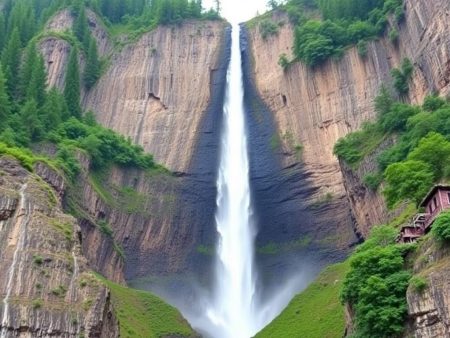Los picos imponentes siempre han cautivado la imaginación de aventureros y amantes de la naturaleza. En los vastos y diversos paisajes de América, una montaña se destaca por encima del resto, tanto en altura como en majestuosidad. Conocida por sus impresionantes vistas y desafiantes escaladas, es un destino que inspira admiración y respeto.
Esta increíble montaña no es solo una maravilla geográfica: es un símbolo de la belleza natural
Descubra Denali: la montaña más alta de Estados Unidos y sus impresionantes maravillas
Los picos imponentes siempre han cautivado la imaginación de aventureros y amantes de la naturaleza. En los vastos y diversos paisajes de América, una montaña se destaca por encima del resto, tanto en altura como en majestuosidad. Conocida por sus impresionantes vistas y desafiantes escaladas, es un destino que inspira admiración y respeto.
Convierte la altura de las personas, edificios, montañas y monumentos más altos a m, pies y pulgadas para comparar
0' 0" es igual a 0,0 cm o 0,00 m.
Esta increíble montaña no es solo una maravilla geográfica, es un símbolo de la belleza y el poder de la naturaleza. Ya seas un escalador experimentado o alguien que simplemente disfruta de maravillarse con las maravillas naturales del mundo, aprender sobre la montaña más alta de Estados Unidos sin duda despertará en ti una sensación de asombro.
Vista general de la montaña más alta de América
El monte Denali, también conocido como monte McKinley, ostenta el título de la montaña más alta de Estados Unidos. Con una altura de 6.190 metros sobre el nivel del mar, es el pico más alto de Norteamérica. Se encuentra en el centro-sur de Alaska, dentro del Parque Nacional y Reserva Denali, y domina el paisaje de Alaska.
Rodeado de terreno accidentado y glaciares, Denali cuenta con dos cumbres principales: la Cumbre Sur, la más alta de las dos, y la Cumbre Norte. Su enorme desnivel, medido desde la base hasta la cima, supera los 5.500 metros, superando a picos prominentes como el Everest en esta métrica.
El Denali atrae a montañistas de todo el mundo por sus condiciones climáticas extremas y sus desafíos técnicos. Cada año, alrededor de 1200 escaladores intentan alcanzar su cumbre, aunque solo unos 50% lo logran debido a la altitud, el terreno y las inclemencias del tiempo. Su nombre, Denali, que significa "El Alto" en koyukon atabascano, refleja su importancia cultural para los pueblos indígenas de Alaska.
Denali: el pico más alto
Denali, la montaña más alta de América, se eleva a 6.190 metros sobre el nivel del mar. Su prominencia y majestuosa presencia la convierten en un elemento central de la geografía y la cultura norteamericanas.
Ubicación y geografía
Denali se encuentra en el centro-sur de Alaska, dentro del Parque Nacional y Reserva Denali, que abarca más de 6 millones de acres de naturaleza salvaje. El parque cuenta con diversos ecosistemas, desde bosques de taiga hasta tundra alpina. La montaña en sí se eleva espectacularmente desde su base, lo que crea uno de los ascensos verticales más altos del mundo. La Cumbre Sur es el verdadero punto más alto, mientras que la Cumbre Norte es un poco más baja. Sus laderas cubiertas de glaciares alimentan importantes sistemas fluviales, incluidos los glaciares McKinley y Ruth.
Importancia histórica
Denali tiene importancia cultural e histórica, en particular para el pueblo athabaskan koyukon, nativo de Alaska, que lo llamó "El Alto". En 1896, un buscador de oro introdujo el nombre de monte McKinley en honor al presidente William McKinley, a pesar de que no existe una conexión directa entre McKinley y Alaska. El nombre fue restaurado oficialmente a Denali en 2015 por el gobierno de los EE. UU., reconociendo su herencia indígena. La exploración de la montaña comenzó a fines del siglo XIX, y la primera ascensión exitosa ocurrió en 1913 por Hudson Stuck, Harry Karstens, Walter Harper y Robert Tatum.
Desafíos y aventuras de escalada
Llegar a la cima del Denali es uno de los logros más difíciles del montañismo. Los escaladores se enfrentan a temperaturas extremas, que a menudo caen por debajo de los -40 °F (-40 °C), y a condiciones climáticas impredecibles. La gran altitud y el aire enrarecido exigen una aclimatación precisa para evitar el mal de altura. Las rutas populares, como la West Buttress, presentan grietas, glaciares escarpados y caras de hielo. Las avalanchas y las tormentas de nieve aumentan aún más los riesgos. A pesar de estos desafíos, el Denali atrae a más de 1200 escaladores al año, con una tasa de éxito de aproximadamente 50%. Para un ascenso seguro, es esencial contar con guías experimentados y una preparación intensiva.
El ecosistema único de Denali
El ecosistema de Denali combina una flora y una fauna diversas y condiciones climáticas extremas, condicionadas por su altitud y latitud. Es el sustento de una vida que se ha adaptado para sobrevivir en algunas de las condiciones más duras de la Tierra.
Flora y fauna
Denali alberga más de 1.500 especies de plantas y numerosas especies animales adaptadas a su entorno único. Las flores silvestres, como las amapolas árticas y la hierba de San Juan, prosperan durante la corta temporada de crecimiento. Los arbustos de bajo crecimiento y los musgos dominan las áreas de tundra, mientras que los abetos y los abedules pueblan las elevaciones más bajas.
La fauna silvestre incluye osos pardos, alces y caribúes, que deambulan por los vastos paisajes del parque. Son comunes los mamíferos más pequeños, como las marmotas y las ardillas terrestres. En toda la región se pueden ver especies de aves, como águilas reales, perdices nivales y alondras cornudas. El parque también alberga vida acuática, incluidos los tímalos árticos en ríos alimentados por glaciares.
Condiciones climáticas
Denali experimenta variaciones climáticas severas influenciadas por su altitud y ubicación geográfica. Las temperaturas en las zonas más altas caen por debajo de los -40 °F (-40 °C), mientras que en las zonas más bajas se producen cambios estacionales. Los inviernos son largos y duros, con fuertes nevadas, y los veranos son breves pero ofrecen condiciones suaves con temperaturas que alcanzan los 60 °F (16 °C).
La velocidad del viento en la montaña puede alcanzar los 160 km/h (100 mph), especialmente en las altitudes más altas. Las precipitaciones varían, con fuertes nevadas en las laderas más altas. Estas condiciones suponen un desafío tanto para la flora y la fauna de la zona como para quienes se aventuran a explorar su accidentado terreno, lo que contribuye a la reputación de Denali como una maravilla natural imponente.
Comparación del Denali con otros picos altos
Denali domina Norteamérica no solo por su altura, sino también por sus características y desafíos únicos. Comparado con otros picos emblemáticos, ofrece una experiencia distinta determinada por su ubicación y sus condiciones.
¿Por qué Denali se destaca?
El Denali, que se eleva a 6.190 metros, supera a todas las demás montañas de Norteamérica en cuanto a elevación. Su ascenso vertical desde la base hasta la cima, de más de 5.500 metros, es uno de los más espectaculares del mundo. A diferencia del Aconcagua de los Andes, de 6.961 metros, o del Everest del Himalaya, de 8.849 metros, el Denali se encuentra en las latitudes más septentrionales, lo que lo somete a condiciones más duras y frías. Su latitud también reduce el espesor atmosférico, lo que hace que el nivel de oxígeno sea comparable al de picos de más de 7.000 metros en otros lugares.
La naturaleza remota de Denali contrasta con picos como el Mont Blanc (4.800 metros) en Europa, que es más accesible y está rodeado de pueblos alpinos. El terreno de Denali incluye glaciares enormes como el glaciar Kahiltna, que le aportan un carácter majestuoso y a la vez accidentado.
Diferencias en las experiencias de escalada
El Denali pone a prueba a los escaladores con condiciones climáticas adversas y desafíos técnicos. Si bien el Everest puede exigir aclimatación a altitudes mayores, los escaladores del Denali se enfrentan a tormentas de nieve impredecibles y vientos que alcanzan los 160 km/h (100 mph). Sin infraestructura como cuerdas fijas u oxígeno suplementario, el ascenso depende completamente de la capacidad del equipo.
En los Andes, el Aconcagua es técnicamente menos exigente, aunque la altitud extrema plantea riesgos. Picos como el Cervino de los Alpes requieren habilidades técnicas más agudas, pero carecen del aislamiento sostenido del Denali. La lejanía de la montaña de Alaska, las temperaturas extremas que alcanzan los -40 °F (-40 °C) y la autosuficiencia prolongada hacen que su ascenso sea único. Los escaladores deben llevar equipo para semanas y enfrentarse a glaciares llenos de grietas, algo muy diferente de otras ascensiones bien asistidas en todo el mundo.
Consejos de viaje para visitar Denali
Los vastos paisajes y los imponentes picos de Denali atraen a aventureros y entusiastas de la naturaleza por igual. Una planificación adecuada mejora la experiencia de explorar este destino icónico.
Los mejores momentos para visitar
Los meses de finales de mayo a principios de septiembre ofrecen las mejores condiciones para visitar Denali. Los veranos traen temperaturas más suaves, con máximas diurnas que oscilan entre 15 °C y 21 °C (60 °F y 70 °F) en las zonas más bajas y con más horas de luz. La actividad de la vida silvestre está en su apogeo en estos meses, ya que se pueden ver con más frecuencia osos pardos, alces y caribúes. Junio y julio ofrecen un clima óptimo para practicar senderismo y hacer turismo, mientras que agosto y principios de septiembre muestran los colores del otoño. Las visitas en invierno son limitadas debido a las duras condiciones, la nieve profunda y las temperaturas bajo cero, que restringen el acceso a muchas áreas.
Tours y expediciones guiadas
Numerosas empresas organizan excursiones y expediciones guiadas en el Parque Nacional Denali. Las excursiones en autobús por el parque, como la Tundra Wilderness Tour, ofrecen observación de la vida silvestre y paradas panorámicas a lo largo de la carretera de 92 millas del parque. Los paquetes de excursiones guiadas con mochila y senderismo se adaptan a distintos niveles de habilidad, desde caminatas de un día para principiantes hasta viajes de varios días. Para los escaladores, operadores especializados ofrecen ascensos guiados al Denali, que suelen durar entre 2 y 3 semanas, incluidos períodos de aclimatación y asistencia técnica. Las excursiones aéreas ofrecen vistas impresionantes de los picos y glaciares del Denali, con opciones de aterrizajes en los glaciares Kahiltna o Ruth, lo que enriquece la perspectiva del visitante de la belleza agreste del parque.
Conclusión
Denali es un testimonio de la grandeza de la naturaleza y cautiva a aventureros, amantes de la naturaleza y entusiastas de la cultura por igual. Su imponente presencia, su belleza agreste y su rica historia lo convierten en un símbolo tanto de desafío como de inspiración. Ya sea que se lo admire desde lejos o se lo explore de cerca, Denali ofrece una experiencia inolvidable que deja una impresión duradera en todos los que se acercan a sus majestuosas alturas.
Preguntas frecuentes
¿Qué es Denali y dónde está ubicado?
Denali, también conocido como monte McKinley, es la montaña más alta de Norteamérica, con una altura de 6.190 metros. Se encuentra en el centro-sur de Alaska, dentro del Parque Nacional y Reserva Denali, una zona silvestre de 2,4 millones de hectáreas.
¿Por qué es tan difícil escalar el Denali?
Denali es un desafío debido a su clima extremo, terreno técnico y gran altitud. Los escaladores se enfrentan a temperaturas de hasta -40 °F (-40 °C), fuertes vientos de más de 100 mph y un enorme desnivel de más de 18 000 pies desde la base hasta la cima, lo que requiere una preparación y un estado físico excepcionales.
¿Cuál es la mejor época para visitar el Parque Nacional Denali?
La mejor época para visitar el Parque Nacional Denali es desde finales de mayo hasta principios de septiembre. Durante este período, las temperaturas son más suaves, la vida silvestre es más activa y el parque ofrece diversas actividades, como recorridos, caminatas y vistas aéreas de la montaña.
¿Cuántos escaladores logran coronar con éxito el Denali cada año?
Aproximadamente 1.200 escaladores intentan alcanzar la cima del Denali cada año, pero solo alrededor de 50% lo logran debido al clima severo, los desafíos de altitud y las difíciles condiciones de escalada.
¿Qué hace que Denali sea diferente de otras montañas altas?
La latitud extrema norte del Denali, los niveles reducidos de oxígeno y la naturaleza remota lo distinguen. A diferencia de picos como el Monte Everest, el Denali requiere autosuficiencia, sin cuerdas de apoyo ni oxígeno suplementario, lo que lo convierte en una escalada excepcionalmente accidentada y exigente.
¿Cuál es el significado cultural de Denali?
Denali, que significa “El Alto”, tiene una enorme importancia cultural e histórica para el pueblo atabascano koyukon, y su nombre original refleja su herencia indígena. En 2015, este nombre fue restaurado oficialmente, en honor a su importancia nativa.
¿Qué fauna y plantas se pueden encontrar en Denali?
Denali cuenta con más de 1500 especies de plantas, entre ellas amapolas y musgos árticos, y una fauna diversa, como osos pardos, alces, caribúes, marmotas y águilas reales. Ofrece un ecosistema único, determinado por su altitud y su duro clima.
¿Hay visitas guiadas disponibles a Denali?
Sí, se ofrecen muchas visitas guiadas, incluidas excursiones en autobús, caminatas guiadas, expediciones de escalada y excursiones aéreas. Estas opciones ayudan a los visitantes a explorar el parque de manera segura y apreciar sus impresionantes paisajes y vida silvestre.
¿Cómo afecta el clima de Denali a los visitantes y escaladores?
El clima de Denali varía enormemente, con inviernos largos y rigurosos y veranos breves y templados. Las condiciones climáticas extremas, con temperaturas bajo cero, vientos fuertes y tormentas de nieve frecuentes, plantean serios desafíos tanto para los visitantes como para los escaladores.
¿Quién fue el primero en escalar con éxito el Denali?
La primera ascensión exitosa del Denali ocurrió en 1913 por Hudson Stuck, Harry Karstens, Walter Harper y Robert Tatum, marcando un logro histórico en la historia del montañismo.





